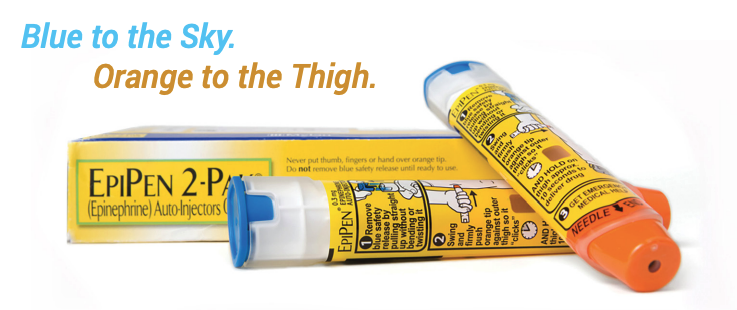Epi-Pen: How to Use an Epi-Pen® Auto-Injector
This WorkCare Fact Sheet explains how to use an epinephrine auto-injector to treat a severe allergic reaction.
An emergency medical response is required in response to anaphylaxis, a potentially life-threatening allergic reaction. Anaphylaxis occurs when the immune system overreacts to an allergen by releasing chemicals that trigger severe allergy symptoms.
If a person experiencing a severe allergic reaction carries an epinephrine auto-injector (e.g., EpiPen®), it may be necessary for you to administer medication before emergency responders arrive. In some cases a person suffering an allergic reaction will be able to self-administer the injection but need assistance getting emergency follow-up care.
EpiPen auto-injectors are pre-filled, single-use devices. They contain one dose of epinephrine, a chemical that narrows blood vessels and opens airways in the lungs. The injection may be done through clothing and, if necessary, when the person is in shock or unconscious.
Signs and symptoms of a severe allergic reaction may include:
- Swelling of the throat, lips or tongue
- Swelling throughout the body
- Difficulty breathing and/or swallowing
- Abdominal cramps, nausea, vomiting or diarrhea
- Rapid heart rate
- Drop in blood pressure
- Sudden weakness
- Hives (swollen bumps or wheals on the skin)
- Skin flushing with redness and warmth
Common Causes of Severe Allergic Reactions
Certain foods, medications, insect stings and bites, and exposure to products containing natural rubber latex are common causes of severe allergic reactions.
A food allergy occurs when the body’s immune system attacks a protein. Studies show that eight types of food cause most allergic reactions in the U.S. population: milk, egg, peanut, tree nuts, soy, wheat, fish and shellfish. Research suggests a mix of genetic and environmental influences play a role in the development of food allergies.
According to the American Academy of Allergy, Asthma and Immunology, common triggers of drug allergies include:
- Penicillin and related antibiotics
- Antibiotics containing sulfonamides (sulfa drugs)
- Anticonvulsants
- Aspirin, ibuprofen and other nonsteroidal anti-inflammatory drugs (NSAIDs)
- Chemotherapy drugs
The Asthma and Allergy Foundation of America reports that many different kinds of insects or bugs can cause an allergic reaction. The most common culprits include:
- Stinging insects – Bees, wasps, hornets, yellow-jackets and fire ants
- Biting insects – Mosquitoes, kissing bugs, bedbugs, fleas, certain flies and some ticks
- Household pests – Cockroaches and dust mites
People who are allergic to latex are sensitized to proteins in natural rubber latex from tree sap, not to synthetic rubber made from chemicals. Natural rubber latex is used in the manufacture of medical supplies and many consumer products. People who suspect they may be allergic should check product labels before use.

Using the Epi-Pen
Precautions
- Never put your thumb, fingers or hand over the orange tip.
- Do not remove the blue safety release until you are ready to use the auto-injector.
- Do not use the device if the solution appears discolored or has particles in it, or the date for use has expired.
- Use the auto-injector only one time; do not try to reinsert it a second time.
- Do not use more than two fresh injections consecutively.
Directions
- Unsnap the yellow cap on the carrier tube and remove the EpiPen auto-injector.
- Form a fist around the auto-injector with the orange tip down.
- Pull the blue safety cap straight up with your other hand; do not twist or bend.
- Place the orange tip against the middle of the outer thigh at a 90 degree angle (perpendicular to the leg).
- Swing and firmly push the orange tip into the outer thigh until it clicks.
- Hold firmly against the thigh for approximately three seconds – count slowly to three.
- Remove the unit from the thigh and massage the injection site for 10 seconds.
- After injection the orange cover automatically closes to ensure the needle is not exposed.
- Call 911 and request immediate medical attention or take the person to the nearest hospital.
- Give the used auto-injector to first responders or emergency room personnel so they will know how much epinephrine was administered.
The effects of epinephrine may wear off within 10 to 20 minutes, or there may be a secondary reaction. Emergency medical follow-up is required.
DOWNLOADLet’s Work Together
Ready to take your workforce health and safety to the next level?
Contact us today to learn how WorkCare can partner with you to create a healthier, safer, and more productive workplace.
